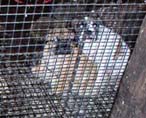 issue |
issue > message
animal suffering Ventral Lid Bilateral Entropion. It’s a painful condition where a dog’s eyelids turn inward so that his or her lashes scratch the corneas. If not corrected, the dog could go blind. A dog may have this condition but look perfectly healthy. Due to cost (surgery is an estimated $275-$350 per eye), profit-driven breeders may not consider it worthy of correcting and so deny an animal veterinarian care. The Wisconsin Puppy Mill Project has profiled Max the Boxer, who had this condition. View the story at the link below.
Overview Animals can suffer physically and psychologically. Animal suffering, at the hands of inhumane dog and cat breeders, has been documented extensively through facility inspections, cruelty investigations and animal rescues as well as veterinarian reports and general research. Numerous stories, photos and exposes can be found on the Internet. See web links.
Physical suffering: The need for stronger animal care standards Physical suffering is the easiest to see or prove. Some breeding facilities house dogs or cats in cages made of wire which are stacked on top of each other. Feces and urine from top cages fall on to animals below. This poor sanitation (excessive feces and urine) results in skin infections, parasites and the spread of disease between animals — and pain and suffering to the animals. High-density caging (multiple animals in small cages) combined with inadequate or poor quality food and water also creates stress in animals which reduces animal immune systems, making them more susceptible to disease or other debilitating conditions. Diseases and conditions common to puppy mills: eye lesions, deafness, cataracts, epilepsy, retinal degeneration, hip dysplasia, dislocated kneecaps, glaucoma, retardation, mammary tumors, and periodontal disease. As noted above, one common ailment with puppy mill dogs is “dislocated kneecaps.” Animals who are kept for long periods in cramped cages with little or no exercise and poor nutrition can develop wobbly kneecaps due to insufficient muscle growth. The wired cages can also cause physical harm to the animals’ paws and legs, as they struggle to stand on the wire and keep their legs from falling through and getting caught or mangled. Damaged animals are killed or sold at auction (though injured or deformed, they’re still considered viable for breeding). Puppy mills cull puppies with ‘defects.’ These defects could include a dog that has too short of a tail, a sparse coat, undescended testicles, an umbilical hernia, or is just too small or too large. Other defects due to captivity and inhumane conditions include animals with loss of limbs or bones, deformed or broken legs from overcrowded wire cages, abscessed feet or hyperflexion. Psychological suffering: The need for exercise, human contact and socialization Anyone who has been in a puppy or kitten mill or at a backyard breeder has witnessed dogs, puppies, cats and kittens cowering in the corner, afraid to approach humans or show affection. The psychological and emotional well-being of an animal is as critical as the physical well-being. Because standards, inspections and enforcement of breeding conditions are minimal (by the USDA), non-existent (by the State of Minnesota) or inadequate based on the needs of the animal and breed, psychological problems develop with the animals, such as trauma, extreme fear, kennel shyness, stress and aggression. Scientific reports confirm this. To cite a few reports:
This is why “environmental enrichment” — creating a physical environment that promotes the overall psychological well-being of the animal — is a priority for many animal welfarists and advocates. The Minnesota Commercial Dog and Cat Breeder law (passed in 2014), requires breeders (who meet the definition of the law) to provide daily enrichment and twice daily positive physical contact with humans and their own species. The MN Board of Animal Health, who administers the law, is responsible for ensuring that these requirements are met. Local governments, when granting conditional use permits, often do not consider psychological factors.
Breeding stock The above describes, in part, living conditions for dogs and cats in breeding facilities which can result in physical or psychological harm to the animals. Improper breeding and care practices of the adult females also creates suffering, where females are kept in cages or pens their entire lives and bred each heat cycle. These breeding females are known as “brood bitches.” The Internet has numerous stories describing these dogs. HSUS profiles one breeding female named CJ, typical of a brood bitch: “The dog, who became known as CJ (short for Calamity Jane), bore all the symptoms of a puppy-mill breeding female. She not only had the blank expression and frail, bald body of a perpetually neglected animal, but also had untreated sarcoptic mange, ringworm, skin infections, dermatitis, ear infections, arthritis in her back legs (from years of close confinement), and early cataracts. What’s more, she had lost many of her teeth … due to poor care and nutrition.” Emotional distress with adult females, including mental breakdowns, has been documented. A Minnesota USDA-licensed breeder (Dayna Bell), who has been convicted of 13 felonies of animal cruelty, argued that her "breeding adults dogs" were, essentially, livestock and not pet/companion animals. This argument was made at trial. The jury did not agree. Bell appealed the case to the Court of Appeals, who affirmed the jury's decision. Bell then filed a petition with the MN Supreme Court who denied hearing the case. To learn more, go to: Dayna Bell - Dog Breeder
Supporting links
|
 |
"));